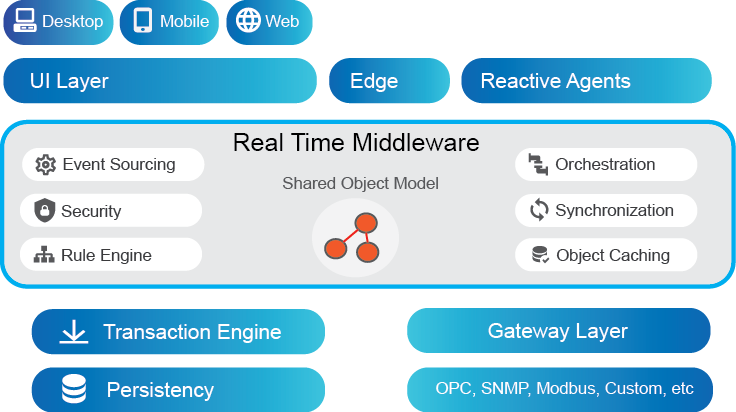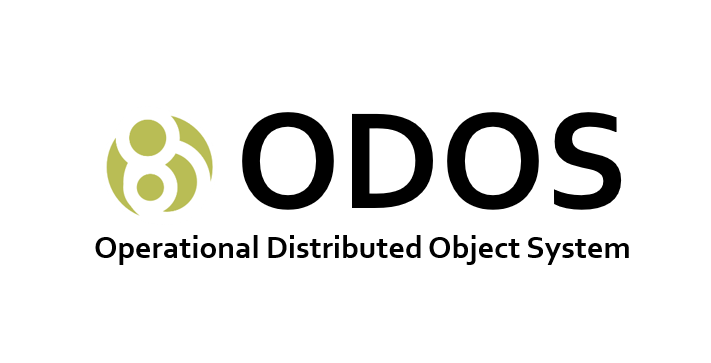It’s about time to describe ODOS better. We will begin with a high level view to give the big picture.
ODOS (Operational Distributed Object System) is our lightweight middleware that helps us built operational distributed solutions. After many years of development, it is in production state since 5 years. It was originally designed for rapid development of applications targeting robust loosely connected human operations on the field, such as connected maintenance workers and first responders. Such applications require continuously updated complex data on the client, rich visualizations, responsiveness, offline usage and resynchronization. In the backend side, these applications require real time processing, low latency and integration with third party systems and devices. By providing such features mobile users can perform efficient and seamless operations.
Nowadays, mobile and edge devices are continuously expanding, new sensors are being incorporated everywhere and everything is interconnected. A vast amount of machine data is produced and processed. Additionally, mobile users demand responsiveness and low latency from all apps, both commercial and business ones. So current successfully applications are by default distributed with many layers and node types. Additionally they should seamlessly blend machine and human data into a common domain model, may have integrations with third party systems and must provide an intuitive and responsive HMI in various hardware platforms. But consider the cost on building such distributed applications, for example a location based commercial platform for ride sharing. It requires many teams that have to master various different technologies. ODOS targets to become the cost effective Universal Platform that will tackle the complexity and provide the infrastructure for any distributed application.
ODOS is built in .NET and consists of a set of libraries, reusable ready made components and productivity tools. We have made the choice to not depend on other implementations (neither open source nor commercial) for the core components, so we can achieve maximum flexibility and control of the functionality. However, we have already built many binding components to support various industry standard technologies and enterprise libraries. From an architectural point of view, ODOS is built around the Distributed Shared Object (DSO) abstraction, an object oriented Distributed Shared Memory (DSM) concept, where the state of the domain entities is shared amongst all nodes. In ODOS this is done transparently as it hides from the developer the communication and persistence layer almost completely. ODOS is also Event Driven as any change on any single object property may trigger a reaction that runs in a system node.

Some of the notable features of ODOS are the strong UML based domain oriented modelling “language”, the rich declarative model for entity characteristics, the low latency, the enterprise-ready role-based security model, the powerful integration engine that helps us build easily gateways to third party systems, the live collections, the visualization components, the out of the box distributed caching that provides horizontal scalability. What is even more interesting is how lightweight ODOS is. Just to mention some numbers, the object server comes with a baseline of 80 MB memory footprint and about 40 MB deployment size.
By providing an architecture like that, we can achieve minimal development effort and very gentle learning curve, maximizing the agility and maintainability of the code. The developers feel like building standalone applications and not distributed ones. So even few developers can build very powerful applications, minimizing the implementation cost and risk.
Up until now, on top of ODOS, we have built EORON, an operations management and system monitoring platform. EORON provides the engine to build customized monitoring, data collection and operations management applications. We also provide Is2Aware, a specialization of EORON for physical security operations of large infrastructures. This system falls under the category of Physical Security Information Management (PSIM) systems. Both of them prove the capabilities of ODOS.
ODOS is continuously evolving with new features and enhancements. What we currently do is to migrate ODOS to .NET standard and built reusable libraries for ASP.NET Core and Xamarin.
We are open to partnerships with anyone interested in our technology. Early adopters will get special prices and support by the creators of ODOS. We are also positive on providing ODOS to promising startups free of charge till they reach some revenue levels in a mutually beneficial agreement.
Stay tuned to learn more or drop us a line.

